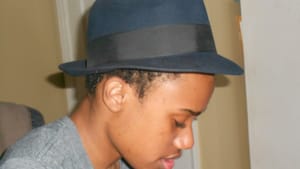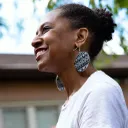Stay in the Loop
BSR publishes on a weekly schedule, with an email newsletter every Wednesday and Thursday morning. There’s no paywall, and subscribing is always free.
The power of art
An autistic artist communicates

My days have been overstuffed, of late, but when Sue Schaeffer called with an SOS, I decided to help. Sue, who uses a wheelchair, is a passionate advocate for people with disabilities. She knows that my son, Malcolm, is on the autism spectrum. She was hoping that Malcolm and I could share something of his experience with some elementary school kids as part of an after-school program in Lancaster’s version of the inner city, replacing her scheduled presenter who had canceled at the last minute.
I arrived a bit late and was happy to find the children seated and relatively quiet. Malcolm isn’t overly verbal, so I knew the communicating part would be up to me. At least, I thought it would, although as it turned out, Malcolm said a lot without using a single word.
An unexpected business
The topic I chose was Malcolm’s Tiles, the business I have been running on my son’s behalf since August, growing out of his obsession with an amusement park in the Netherlands he’d seen on YouTube. At first, I thought that Julianatoren was a girl. I explained to him repeatedly that you can’t meet random European females you’ve seen online, only to discover that he was talking about a park named after Queen Juliana. Autistic people can be very persistent; he was driving me crazy, so I told him that when he becomes a famous artist, he can treat his family to a trip.
I wasn’t serious, but I’d planted a seed. My mother, who happened to be visiting, commissioned Malcolm to create souvenirs for her friends back home. Malcolm had drawn cartoons on four-inch square tiles as a fundraiser for his learning support  class. I figured that if he could do it for them, why not do it for himself? My mom’s friends were very interested in Celtic art, so I found some public domain Celtic crosses online and let her choose the ones she liked.
class. I figured that if he could do it for them, why not do it for himself? My mom’s friends were very interested in Celtic art, so I found some public domain Celtic crosses online and let her choose the ones she liked.
Even though I’d supplied the designs, I was blown away when I saw the first examples of my son’s Celtic cross tiles. It’s difficult to describe how much skill goes into his work — he traces a circle, then draws, freehand and with great precision, an intricate picture with oil-based markers (to watch him work, click here for a link to the feature produced by members of the communications class at his high school). I posted them on Facebook, and he received his first orders from outside the family. Then my entrepreneurial sister stepped in by creating a website, for which she is the guru. Malcolm hasn’t raised enough money to go to Europe, but he’s learning a lot about the idea that hard work can create financial rewards. Along the way, I’m learning business lessons I’ve resisted all of my life, probably to my own financial detriment. So everybody is winning here.
Sharing his story
I told Sue’s class a little bit about autism and that Malcolm first showed evidence of artistic ability by drawing the clues from Blue’s Clues at the age of about two or three. When I asked if any of the children watched Blue’s Clues, one little boy raised his hand, but he quickly lowered it when the others made it clear that Blue’s Clues wasn’t cool. Later, though, I was glad to see the herd dynamic shift in a more positive direction when I discovered that almost all of the children liked to draw and that people in their families often encouraged them.
When I asked if anyone knew someone who was autistic, one little girl raised her hand. Meanwhile, Malcolm was sitting at a small table, drawing. As the session ended, all of the little kids crowded around him and were excited at what they saw. A number of them said they wanted to buy his artwork. I was particularly touched when the little boy who used to watch Blue’s Clues said, for reasons that are unclear to me, that he wished Malcolm were his brother.
I was moved by seeing all of those little brown faces become more animated as the half hour went by and all pretense of cool faded away. They were so excited about art and life. I hate to project, because I know nothing about those children. I do know, however, about this harsh world, which is often even harsher if you come from the neighborhood where that center is located.
What awaits them? Will the little boy who liked Blue's Clues still have a light in his eyes when he's 17? I don't want to assume anything — they may all have wonderfully stable homes, just as a lot of rich kids have homes that are completely dysfunctional. Still, my heart breaks for those who will, in 20 years, have stuffed their interest in diverse expressions of beauty deep inside, just to conform to the narrow parameters to which society — and I include black society here — tries to confine them.
Sign up for our newsletter
All of the week's new articles, all in one place. Sign up for the free weekly BSR newsletters, and don't miss a conversation.
 Maria Thompson Corley
Maria Thompson Corley